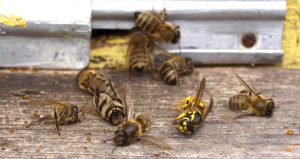13
Jan
EPA Announcement on Bee-Toxic Pesticides At Odds with Latest Independent Science on Neonicotinoids
(Beyond Pesticides, January 13, 2016) Just prior to the U.S. Environmental Protection Agency (EPA) announcement on January 12 that several neonicotinoid insecticides “do not pose significant risks to bee colonies,” the preprint version of a new review of neonics identified the range of lethal and sublethal effects of the chemicals on non-target organisms. The review, The Environmental Risks of Neonicotinoid Pesticides: a review of the evidence post-2013, authored by Dave Goulson, PhD, and Thomas James Wood, a PhD candidate, concludes that studies published since the 2013 European Food Safety (EFSA) published risk assessments show even greater risks. The EFSA assessment, which led to a moratorium on neonicotinoid uses, found that certain neonics on specific flowering crops pose a high risk to bees.
With reference to the 2013 EFSA risk assessment conclusions as their baseline, the researchers summarize the difference in risk for certain categories, including:
- “Risk of exposure from and uptake of neonicotinoids in non-crop plants. Uptake of neonicotinoids by non-target plants was considered likely to be negligible, though a data gap was identified. Many studies have since been published demonstrating extensive uptake of neonicotinoids and their presence in the pollen, nectar and foliage of wild plants. Exposure from non-target plants clearly represents a Greater Risk.”
- “Sublethal effects of neonicotinoids on wild bees. Consideration of sublethal effects by EFSA was limited as there is no agreed testing methodology for the assessment of such effects. Exposure to neonicotinoid-treated flowering crops has been shown to have significant negative effects on free flying wild bees under field conditions and some laboratory studies continue to demonstrate negative effects on bee foraging ability and fitness using field-realistic neonicotinoid concentrations. Greater Risk.”
The review also delves into areas of study that were not considered by EFSA, such as the impact of neonicotinoids on environmental health. The researchers compile a range of risks to non-target organisms, including the death of beneficial predator populations, the persistence of neonicotinoids in soils, which leads to constant contamination and accumulation over time, to a higher sensitivity of aquatic organisms to neonicotinoids. The authors make the case that, due to this new evidence demonstrating greater risk to bees and the environment, the current moratorium on imidacloprid, clothianidin and thiamethoxam in Europe should be extended, and that the partial ban should be expanded to other neonic uses.
This review adds merit to the body of research regarding neonicotinoids and their impacts on pollinators and other non-target beneficial species. Neonicotinoids are a class of insecticides that share a common mode of action that affects the central nervous system of insects, resulting in paralysis and death. While the issue of pollinator declines is diverse and complex, with many factors potentially contributing to the cause, pesticides have consistently been implicated as a key factor, not only through immediate bee deaths, but also through sublethal exposure. Neonics are associated with decreased learning, foraging and navigational ability, as well as increased vulnerability to pathogens and parasites as a result of suppressed bee immune systems. In addition to toxicity to bees, pesticides like neonicotinoids have been shown to also adversely affect birds, aquatic organisms and contaminate soil and waterways, and overall biodiversity.
In light of the shortcomings of federal action in the U.S. to protect these beneficial organisms, it is left up to us to ensure that we provide safe havens for pollinators by creating pesticide-free habitat and educating others to do the same. Beyond Pesticides has created a small pesticide-free garden at our offices in DC to provide habitat and forage for our local pollinators, including a beehive on site. You too can pledge your green space as pesticide-free and pollinator-friendly. It does not matter how large or small your pledge is, as long as you contribute to the creation of safe pollinator habitat. Sign the pledge today. Need ideas on creating the perfect pollinator habitat? The Bee Protective Habitat Guide can tell you which native plants are right for your region. Beyond Pesticides also advocates the adoption of organic land management practices and policies by local communities.
EPA will open a 60-day public comment period when it publishes in the Federal Register its preliminary risk assessments for clothianidin, thiamethoxam, and dinotefuranand and new method for assessing potential exposure risks through pollen and nectar.
All unattributed positions and opinions in this piece are those of Beyond Pesticides.
Source: The Environmental Risks of Neonicotinoid Pesticides: a review of the evidence post-2013











No wonder Trump wants to “clean up” the crooked EPA! They’re obviously bought and paid for by Monsatin!
January 14th, 2017 at 7:38 pm